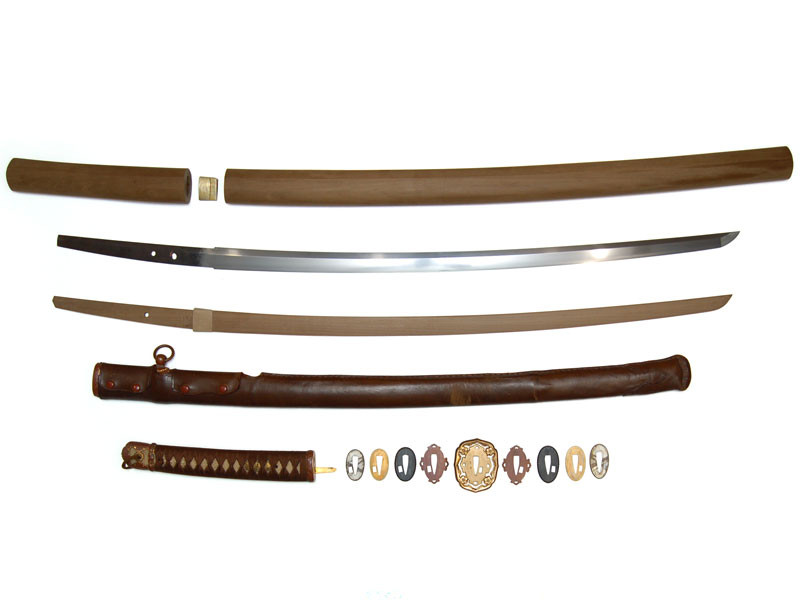














More informations about this product
| Total Weight | 1. 922 kg | |
| Weight without Saya | 1. 143 kg | |
| Blade Weight | 0. 719 kg | |
| Full length Naked Blade (Toshin) |
91.6 cm | |
| Nagasa | 70.2 cm | |
| Tsuka Length | 25.5 cm | |
| Sori (curvature) | 1.82 cm | |
| Kissaki Length | 3.09 cm | |
| Moto Haba | 2.93 cm | |
| Saki Haba | 1.98 cm | |
| Moto Kasane | A = 0.63 cm B = 0.70 cm |
|
| Saki Kasane | A = 0.41 cm B = 0.46 cm |
|
| Curvature | Tori Zori (Bizen Zori) | |
| Type Kissaki | Chū Kissaki | |
| Blade Structure | Shinogi zukuri (diamond shape) O Suri Age | |
| Mune | Iori mune (Triangular) | |
| Hamon | Chū Suguha, Ko Nie Deki with thick Nioiguchi | |
| Hada | Ko Itame Hada with Jinie and Chikei | |
| Boshi | Komaru Kaeri | |
| Nakago | 21,4cm, Mumei, Suri Age, 2 Mekugi Ana, Futsu Gata, Kiri Yasurime (horizontal file marks), Kiri Kurijiri (Horizontal ending) |
|
| Saya | Saya Type 98 gunto covered with a leather scabbard, 78,5 cm length, weight 778g |
|
| Tsuka & Tosogu (Tsuba, Menuki, Fuchi Kashira) |
Set numeroted n°16 - Tsuka: 25.5 cm length, 187g weight, high suality Same, patinated dark brown silk braiding. Gilded Menuki with a 3 Sakura flowers pattern. - Tsuba: 137g weight, external dimensions: 7,18 x 5,92 x 0.5cm, Gunto 98 Type with Sukashi (openings) of very high quality. -Habaki: double Habaki gilded with gold leaf 23g - Seppa: 8 seppa, total weight of 77g (1 copper colored quadrilobed pair, 3 classical seppa pairs, serrated) |
|
| Shirasaya | Total weight of Shirasaya with Tsunagi : 0,486 kg Tsunagi : 0.051 kg Saya length 74.6 cm with a weight of 373g Tsuka length 24.3 cm with a weight of 62g |
|
| Study & Team Review |
Study:
Full set including:- Shirasaya - Jyo saku blade - Gunto Koshirae with Tsunagi - Hozon NBTHK Certificate N°3016758 dated 2018, march 15th - Oshigata Fmith : Yoshihiro 吉広 Province : Hizen Jōō Era (承応): 1652-1655 Honorific Title : Ise No Daijo 伊勢大掾 Yoshihiro, civil name Kichizaemon 吉左衛門, was a smith from the Hizen province (Kyushu), active between 1620 and 1670. The 1st Yoshihiro generation was a student on the very famous and reknowned Hizen Tadayoshi 1st Yoshihiro generation. These two swordsmiths were ranked 'Jo Saku' by the Fujishiro and were ranked "Ryowazamono" for the excellency of the sharpness of their blades. It's also known that Yoshihiro was one of the most talented and appreciated student of Tadayoshi (1st generation). Yoshihiro is known to have took over the formation of Tadayoshi's students, even Tadayoshi's son, Tadahiro (Tadayoshi 2nd generation), assisting this late one on smithing. Together they were collaborating (Gassuku), and Yoshihiro even produced for Tadahiro in the shadows. Yoshihiro was honorifically ranked "Ise no Daijo" during the Kanbun era (寛文, 1661-1673). Following his master (1st generation Tadayoshi), Yoshihiro was mainly working in Ko-Itame grains, Konuka-Hada (Hizenhada) and on straight Hamon, Suguha, Hoso Suguha and Chu Suguha types. Some of his productions were in Gunome Midare. His blades are ofen ranked Tokubetsu: "Major Work" Technical Particularities of the Hizen Shinto Productions:
The Konuka (小糠肌) Hada grain is a steel grain with the pattern of 'Rice Bran'. This grain is typical from the Hizen productions and is even referred as Hizen Hada. This particular grain was created by the Hizen smiths, trying to makeover the Nashiji Hada of the great Yamashiro tradition. This Konuka Hada is so delicately fine and even. Its satined look reminds of the rice powder used as a make-up by Japanese women. Another particularity of the Hizen blades is the fineness of the Kawagane, such limiting the polishes not to reach the Shingane.The Hizen school was one of the most glorious smithing school of the Edo period. It was founded by Hashimoto Shinsaemonjo. This late one was a student of "Umetade Myoju", who took the 'Tada' Kanji, as such to create his artist name '"Tadayoshi". The Tadayoshi style is base on the "Rai" (Yamashiro) smithing school. The Hizen blades, with the patronage of the Daimyo Nabeshima Naoshige, build a reputation on their quality, beauty, handling and efficiency of the cutting edge. The Military Mounting Gunto Type 98:
The mounting Gunto Type 98 Koshirae (1938-1945), is one for the Japanese army officers. The highly worked (opened) tsuba shows it is a mounting for a General. It the first version of the beginning of World War II. One can know the differents Gunto Koshirae by the production's quality and the fineness of the details. With time during World War II, the mounting were lesser and lesser in quality, along with the depletion of materials used in the war effort.Here, we have an openwork Tsuba, Sukashi type, which was use in the early higlhly qualitative mountings. The particuliarity of this mounting is the buckle (Sarute) on the Kashira Kabuto Gane of the handle, made out of a cord, whereas one can more often meet hard alloys buckles. This cord made Sarute's goal was to avoid metallic noises on the battlefield. Overall set in excellent shape, the blade has very few oxydations points, but because the Kawagane is very thin, there is a quite limited number of available polishings. |
|
Share your opinion
error Your review appreciation cannot be sent
feedback Report comment
check_circle Report sent
error Your report cannot be sent